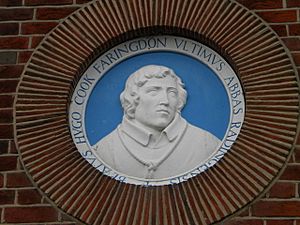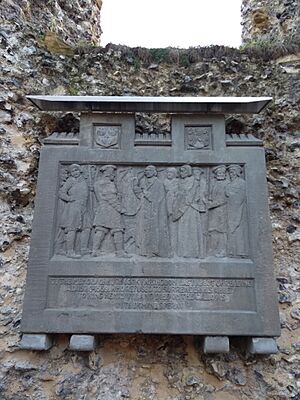Hugh Faringdon facts for kids
Quick facts for kids BlessedHugh Faringdon O.S.B. |
|
|---|---|

Stained glass window at Belmont Abbey
|
|
| Abbot of Reading, Martyr | |
| Born | c. 1490 probably Faringdon |
| Died | 14 November 1539 (aged 48 - 49) Reading Abbey, Reading, England |
| Honored in | Roman Catholic Church |
| Beatified | 13 May 1895 by Pope Leo XIII |
| Feast | 15 November |
| Attributes | reliquary, pastoral staff, martyr's palm, noose in neck |
Hugh Faringdon, OSB (who died on November 14, 1539), was a Benedictine monk. He was the last Abbot of Reading Abbey in Reading, England. During the time when King Henry VIII of England was closing down monasteries, Faringdon was accused of going against the king. He was then executed. In 1895, the Catholic Church declared him a martyr and a blessed person.
Contents
Life of Hugh Faringdon
Hugh Faringdon was born Hugh Cook. He changed his last name to Faringdon when he became a monk before the year 1500. This name change suggests he might have come from the town of Faringdon, which is about 30 miles northwest of Reading. He likely studied at Reading Abbey itself.
Becoming the Abbot of Reading Abbey
Hugh Faringdon became the Abbot of Reading Abbey in 1520. An abbot is like the head of a monastery. Besides his religious duties, he also took on important roles in the community. He served as a Justice of the Peace and helped with government tasks for the area from 1526 to 1538.
Hugh Faringdon and King Henry VIII
At first, Hugh Faringdon seemed to have a good relationship with King Henry VIII of England. The King even visited him on January 30, 1521. Faringdon later became one of the King's personal chaplains, which is a religious advisor. The Abbot of Reading also sent gifts to the King, like fresh fish or hunting knives.
Faringdon also seemed to support the King during his efforts to get a divorce. He sent books to the King that he thought would help his arguments. Faringdon was part of the Parliament from 1523 to 1539. In 1530, he signed a letter to the Pope with other important leaders. This letter explained the problems that could happen if the King's divorce was delayed.
In 1536, he also signed an agreement that recognized the King's power over the Church. In 1537, he took part in the funeral services for Queen Jane Seymour. As late as March 1538, he was still in good standing with the King.
The End of Reading Abbey
When the King's officials came to take over Reading Abbey, they said the abbot seemed willing to cooperate. However, the official document where the abbey was given up does not exist anymore. So, we don't know if Faringdon actually signed it.
Accusation and Execution
In 1539, Hugh Faringdon was accused of going against the King. He was charged with helping rebels in the north of England by giving them money. He was found at his home in Pangbourne and taken to the Tower of London. He stayed there for two months.
Even though he was an important abbot, he was sentenced to death before his trial even began. On November 14, 1539, he was put to death outside the Abbey gatehouse. Two other men, John Rugg and John Eynon, a priest from Reading, were also put to death with him.
John Rugg had been accused of hiding a special religious item from the Abbey. The other monks of Reading Abbey were not accused of treason. They were given money to live on after their monastery was closed.
Legacy and Recognition
Hugh Faringdon was declared a martyr by the Catholic Church. He was recognized as "Blessed" by Pope Leo XIII in 1895. His special day, or feast day, is November 15.
You can find stained glass windows honoring Blessed Hugh in these churches:
- St James' Church in Reading, which is a Catholic church built on part of the old Reading Abbey land.
- Saint Meinrad Archabbey in Indiana, USA. Here, he is shown with two other blessed abbots, Whiting and Beche.
- Belmont Abbey near Hereford, England.
- Saint James Roman Catholic Church in Reading, with his two companions who were also put to death.
There is also a plaque at the English Martyrs Church in Reading that remembers him. A painting of him can be seen in the Our Lady and Saint Anne Church in Caversham, Reading.
He is also shown in a painting called The Martyrdom of Hugh Faringdon, last Abbot of Reading. This painting was made by Harry Morley in 1917 and is now at the Museum of Reading.
The Blessed Hugh Faringdon Catholic School in Reading is named after him. There is also a Catholic church in Faringdon named Blessed Hugh.
See also
- Richard Whiting, the last Abbot of Glastonbury Abbey
- Thomas Marshall, the last Abbot of St John's Abbey, Colchester



